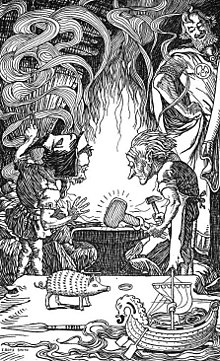Skíðblaðnir

Skíðblaðnir (Old Norse: [ˈskiːðˌblɑðnez̠], 'assembled from thin pieces of wood'[1]), sometimes anglicized as Skidbladnir or Skithblathnir, is the best of ships in Norse mythology. It is attested in the Poetic Edda, compiled in the 13th century from earlier traditional sources, and in the Prose Edda and Heimskringla, both written in the 13th century by Snorri Sturluson. All sources note that the ship is the finest of ships, and the Poetic Edda and Prose Edda attest that it is owned by the god Freyr, while the euhemerized account in Heimskringla attributes it to the magic of Odin. Both Heimskringla and the Prose Edda attribute to it the ability to be folded up—as cloth may be—into one's pocket when not needed.
Attestations
References to the ship occur in the Poetic Edda, the Prose Edda, and in Heimskringla. The ship is mentioned twice in the Poetic Edda and both incidents therein occur in the poem Grímnismál. In Grímnismál, Odin (disguised as Grímnir), tortured, starved, and thirsty, imparts in the young Agnar cosmological knowledge, including information about the origin of the ship Skíðblaðnir:
Benjamin Thorpe translation: Ivaldi's sons went in days of old
Skidbladnir to form,
of ships the best, for the bright Frey,
Niörd's benign son.
Yggdrasil's ash is of all trees the most excellent,
and of all ships, Skidbladnir.
of the Æsir, Odin,
and of horses, Sleipnir,
Bifröst of bridges, and of skallds Bragi,
Hâbrôk of hawks, and of dogs, Garm,
[Brimir of swords.][2]Henry Adams Bellows translation: In days of old did Ivaldi's sons
Skithblathnir fashion fair,
The best of ships for the bright god Freyr,
The noble son of Njorth.
The best of trees must Yggdrasil be,
Skithblathnir best of boats;
Of all the gods is Othin the greatest,
And Sleipnir the best of steeds;
Bifrost of bridges, Bragi of skalds,
Hobrok of hawks, and Garm of hounds.[3]
Skíðblaðnir is mentioned several times in the Prose Edda, where it appears in the books
The boat is first directly addressed in chapter 43; there Gangleri asks that, if Skíðblaðnir is the best of ships, what there is to know about it, and asks if there is no other ship as good or as large as it. High responds that while Skíðblaðnir is the finest ship and the most ingeniously created, the biggest ship is in fact
The next mention of the ship occurs in Skáldskaparmál where, in chapter 6, poetic ways of referring to Freyr are provided. Among other names, Freyr is referred to as "possessor of Skidbladnir and of the boar known as Gullinbursti". The first of the two Grímnismál stanzas mentioned above is then provided as reference.[6]
In chapter 35, a myth explaining Skíðblaðnir's creation is provided. The chapter details that the god
Skíðblaðnir receives a final mention in Skáldskaparmál where, in chapter 75, it appears on a list of ships.[8]
The ship gets a single mention in the Heimskringla book Ynglinga saga. In chapter 7, a euhemerized Odin is said to have had various magical abilities, including that "he was also able with mere words to extinguish fires, to calm the sea, and to turn the winds any way he pleased. He had a ship called Skíthblathnir with which he sailed over great seas. It could be folded together like a cloth."[9]
In popular culture
The animated television series Code Lyoko features a digital submarine named Skidbladnir, named this way due to the Nordic ship's efficiency and usefulness.
In the 2018 game God of War, Skiðblaðnir is mentioned by name, but it is not seen. In its 2022 sequel God of War Ragnarök, Skiðblaðnir is a magical boat that was owned by the Vanir God Freyr, who then gave it to Kratos to use whenever he wants. As it was made by the Vanir Gods, Skiðblaðnir was given the ability to fly and to fold itself when not in use.
See also
- Stone ship, a Germanic burial custom
Notes
References
- American-Scandinavian Foundation.
- ISBN 0-460-87616-3
- ISBN 978-0-292-73061-8
- ISBN 0-85991-513-1
- Thorpe, Benjamin (Trans.) (1866) The Elder Edda of Saemund Sigon. Norrœna Society.
